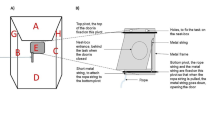Summary
Most of the year the isopod crustacean Hemilepistus reaumuri depends for survival on the protection of a permanent shelter (i.e., the burrow occupied by its family), despite its remarkable physiological adaptations to its desert habitat. If an isopod gets lost after an excursion from the burrow, it has to find it as quickly as possible.
Displacement experiments show that H. reaumuri is indeed successful in homing. Even if a desert isopod is displaced in an arbitrary direction over a distance (starting distance r 0) from the burrow that exceeds 15 times the distance from which it can detect the entrance, it returns on average in less than 400 s.
The homing behavior of H. reaumuri is successful not because of the isopod's ability to navigate to its burrow by using external orientation stimuli but because of the intrinsic structure of its search pattern. An isopod that is displaced from its burrow first searches approximately in the form of a spiral, then it moves through increasing loops on which meanders are superimposed. It concentrates these subunits of its search around the starting point by occasionally returning there. The time course of the azimuthal direction component of its position is not clearly regular. The surroundings of the starting point are searched evenly in every direction.
The search behavior of H. reaumuri is composed of systematic subunits together with many random elements. The form of discrete brownian (random) search without directional correlations between its steps that best describes the observed behavior of H. reaumuri for search-path segments with a length between 1 and 7 m has an average step length of 33 cm. For segments with a searchpath length below 1 m the agreement between theory and observations is better if one starts from a discrete brownian search with a much smaller step length (one body length), but in which the direction of the steps is strongly correlated.
Despite these geometrical similarities to a brownian search the search behavior of H. reaumuri is distinctly more successful because of the combination of two characteristics. H. reaumuri avoids the disadvantage of the most successful form of a brownian search (i.e., the frequent passage through a region in which it has searched just before) by moving in straighter lines. A brownian search with the same directional constancy shown by H. reaumuri would be inefficient because the thoroughness with which a given region is searched would be too low. H. reaumuri avoids this problem and concentrates its search around the starting point by sometimes returning to that place.
Similar content being viewed by others
References
Edney EB (1968) Transition from water to land in isopod crustaceans. Am Zool 8:309–326
Gerritsen J, Strickler JR (1977) Encounter probabilities and community structure in zooplankton: A mathematical model. J Fish Res Board Can 34:73–82
Griffin DR (1952) Bird navigation. Biol Rev 27:359–390
Heinroth O, Heinroth K (1941) Das Heimfindevermögen der Brieftauben. J Ornithol 89:213–256
Hodge CF (1894) The method of homing pigeons. Pop Sci Monthly 44:758–775
Hoffmann G (1978) Experimentelle and theoretische Analyse eines adaptiven Orientierungsverhaltens: Die ‘optimale’ Suche der Wüstenassel Hemilepistus reaumuri, Audouin and Savigny (Crustacea, Isopoda, Oniscoidea) nach ihrer Höhle. Ph D thesis, Regensburg
Hoffmann G (1983) The search behavior of the desert isopod Hemilepistus reaumuri as compared with a systematic search. Behav Ecol Sociobiol 13:93–106
Hoffmann G (1983a) Homing by a systematic search. Proc 8. Cybern Congr (in press)
Koopman BO (1946) Search and screening. Operations Evaluation Group Rep 56, Washington, DC
Kramer E (1976) The orientation of walking honeybees in odour fields with small concentration gradients. Physiol Entomol 1:27–37
Laing J (1938) Host finding by insect parasites. II. The chance of Trichogramma evanescens finding its hosts. J Exp Biol 15:281–302
Lincoln RJ (1970) A review of the species of Hemilepistus s. str. Budde — Lund 1885 (Isopoda, Porcellionidae). Bull Br Mus Zool 20:109–130
Linsenmair KE (1972) Die Bedeutung familienspezifischer Abzeichen für den Familienzusammenhalt bei der sozialen Wüstenassel Hemilepistus reaumuri Audouin u. Savigny (Crystacea, Isopoda, Oniscoidea). Z Tierpsychol 31:131–162
Linsenmair KE (1975) Some adaptions of the desert woodlouse Hemilepistus reaumuri (Isopoda, Oniscoidea) to desert environment. Verh Ges Oekol (Erlangen) 1975:183–185
Linsenmair KE (1979) Untersuchungen zur Soziobiologie der Wüstenassel Hemilepistus reaumuri und verwandter Isopodenarten (Isopoda, Oniscoidea): Paarbindung und Evolution der Monogamie. Verh Dtsch Zool Ges 1979:60–72
Linsenmair KE, Linsenmair C (1971) Paarbildung u. Paarzusammenhalt bei der monogamen Wüstenassel Hemilepistus reaumuri (Crustacea, Isopoda, Oniscoidea). Z Tierpsychol 29:134–155
Mardia KV (1972) Statistics of directional data. Academic Press, London New York
Matthews GVT (1971) Vogelflug. Goldmann, München
Paloheimo JE (1971) On a theory of search. Biometrika 58:61–75
Patten BC (1964) The rational decision process in salmon migration. J Cons Int Explor Mer 28:410–417
Pretzl R (1976) Vergleichende Untersuchungen zur Transpiration und aktiven Wasserabgabe der Wüstenassel Hemilepistus reaumuri (Audouin u. Savigny) und der Kellerassel Porcellio scaber (Latreille). Dissertation, Universität Regensburg
Rennie J (1835) The faculties of birds. London
Rogers DJ (1972) Random search and insect population models. J Anim Ecol 41:369–383
Saila SB, Shappy RA (1963) Random movement and orientation in salmon migration. J Cons Int Explor Mer 28:153–166
Schöne H (1980) Orientierung im Raum. Wiss Verlags-Ges, Stuttgart
Seelinger G (1977) Der Antennenendzapfen der tunesischen Wüstenassel Hemilepistus reaumuri, ein komplexes Sinnesorgan (Crustacea, Isopoda). J Comp Physiol 113:95–103
Stanley J (1932) A mathematical theory of the growth of populations of the flour beetle Tribolium confusum Duv. Can J Res 6:632–671
Tchen CM (1952) Random flight with multiple partial correlations. J Chem Phys 20:214–217
Varley GC (1941) On the search for hosts and the egg distribution of some chalcid parasits of the knapweed gall-fly. Parasitology 33:47–66
Wehner R, Srinivasan MV (1981) Searching behaviour of desert ants, genus Cataglyphis (Formicidae, Hymenoptera). J Comp Physiol 142:315–338
Wilkinson DH (1952) The random element in bird ‘navigation’. J Exp Biol 29:532–560
Author information
Authors and Affiliations
Rights and permissions
About this article
Cite this article
Hoffmann, G. The random elements in the systematic search behavior of the desert isopod Hemilepistus reaumuri . Behav Ecol Sociobiol 13, 81–92 (1983). https://doi.org/10.1007/BF00293798
Received:
Accepted:
Issue Date:
DOI: https://doi.org/10.1007/BF00293798




